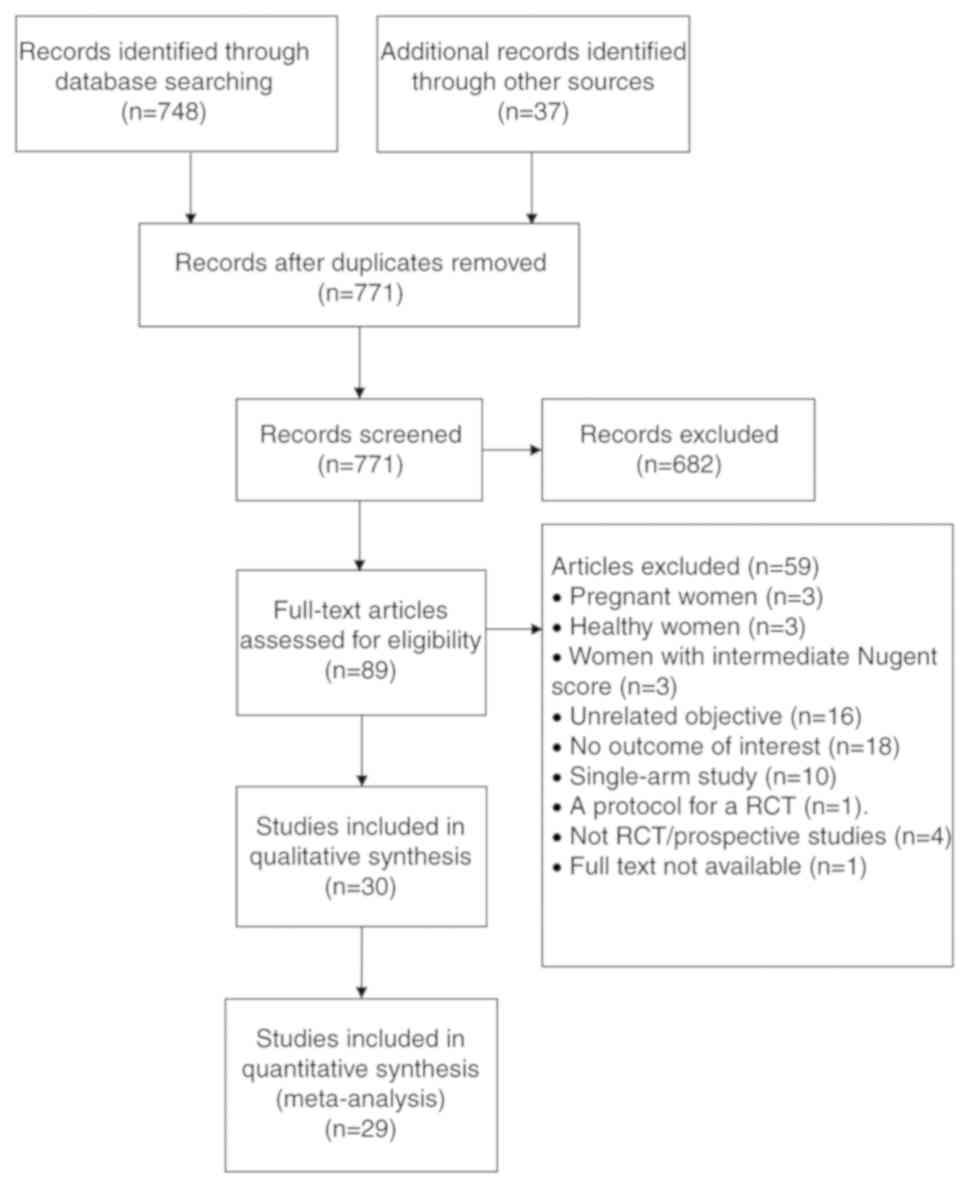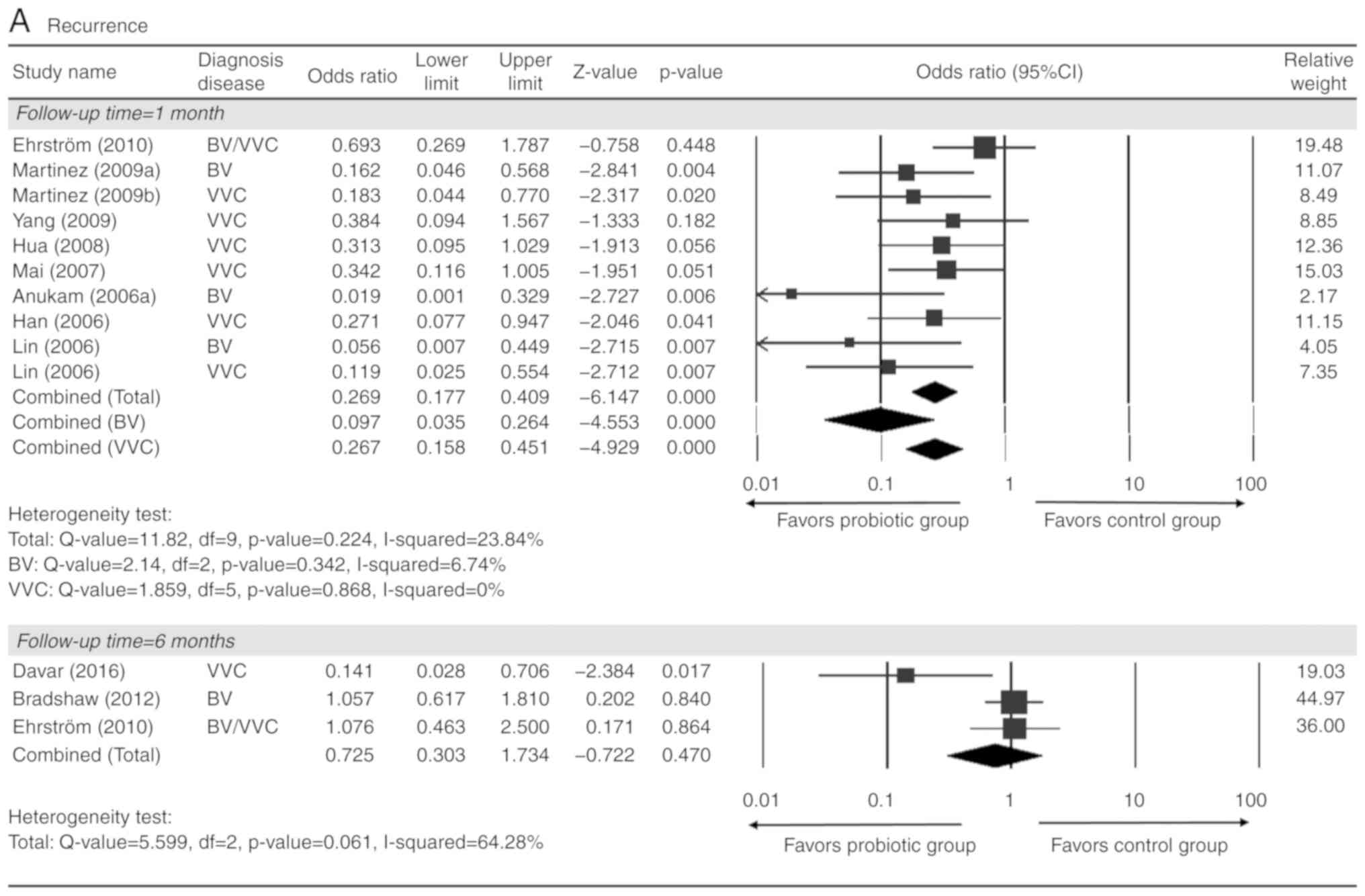|
1
|
Kent HL: Epidemiology of vaginitis. Am J
Obstet Gynecol. 165:1168–1176. 1991.PubMed/NCBI View Article : Google Scholar
|
|
2
|
Mills BB: Vaginitis: Beyond the Basics.
Obstet Gynecol Clin North Am. 44:159–177. 2017.PubMed/NCBI View Article : Google Scholar
|
|
3
|
Huang H, Song L and Zhao W: Effects of
probiotics for the treatment of bacterial vaginosis in adult women:
A meta-analysis of randomized clinical trials. Arch Gynecol Obstet.
289:1225–1234. 2014.PubMed/NCBI View Article : Google Scholar
|
|
4
|
Hanson L, VandeVusse L, Jermè M, Abad CL
and Safdar N: Probiotics for treatment and prevention of urogenital
infections in women: A systematic review. J Midwifery Womens
Health. 61:339–355. 2016.PubMed/NCBI View Article : Google Scholar
|
|
5
|
Reid G: Probiotic use in an infectious
disease setting. Expert Rev Anti Infect Ther. 15:449–455.
2017.PubMed/NCBI View Article : Google Scholar
|
|
6
|
Abad CL and Safdar N: The role of
Lactobacillus probiotics in the treatment or prevention of
urogenital infections-a systematic review. J Chemother. 21:243–252.
2009.PubMed/NCBI View Article : Google Scholar
|
|
7
|
Xie HY, Feng D, Wei DM, Mei L, Chen H,
Wang X and Fang F: Probiotics for vulvovaginal candidiasis in
non-pregnant women. Cochrane Database Syst Rev.
11(CD010496)2017.PubMed/NCBI View Article : Google Scholar
|
|
8
|
Liberati A, Altman DG, Tetzlaff J, Mulrow
C, Gøtzsche PC, Ioannidis JP, Clarke M, Devereaux PJ, Kleijnen J
and Moher D: The PRISMA statement for reporting systematic reviews
and meta-analyses of studies that evaluate health care
interventions: Explanation and elaboration. J Clin Epidemiol.
62:e1–e34. 2009.PubMed/NCBI View Article : Google Scholar
|
|
9
|
Higgins JP: Commentary: Heterogeneity in
meta-analysis should be expected and appropriately quantified. Int
J Epidemiol. 37:1158–1160. 2008.PubMed/NCBI View Article : Google Scholar
|
|
10
|
Sterne JAC, Higgins JPT, Reeves BC on
behalf of the development group for ACROBAT- NRSI. A Cochrane Risk
Of Bias Assessment Tool: for Non-Randomized Studies of
Interventions (ACROBAT- NRSI), Version 1.0.0, 24 September 2014.
http://www.riskofbias.info.
|
|
11
|
Deeks JJ, Higgins JPT and DG A: Chapter
10: Analysing data and undertaking meta-analyses. In: Cochrane
Handbook for Systematic Reviews of Interventions version 6.0
(updated July 2019). Higgins JPT, Thomas J, Chandler J, et
al. (eds.) Cochrane, 2019.
|
|
12
|
Hardy RJ and Thompson SG: Detecting and
describing heterogeneity in meta-analysis. Stat Med. 17:841–856.
1998.PubMed/NCBI View Article : Google Scholar
|
|
13
|
Takkouche B, Cadarso-Suárez C and
Spiegelman D: Evaluation of old and new tests of heterogeneity in
epidemiologic meta-analysis. Am J Epidemiol. 150:206–215.
1999.PubMed/NCBI View Article : Google Scholar
|
|
14
|
National Research Council: Combining
Information: Statistical issues and opportunities for research. The
National Academies Press, Washington, DC, 1992.
https://doi.org/10.17226/20865.
|
|
15
|
Anukam K, Osazuwa E, Ahonkhai I, Ngwu M,
Osemene G, Bruce AW and Reid G: Augmentation of antimicrobial
metronidazole therapy of bacterial vaginosis with oral probiotic
Lactobacillus rhamnosus GR-1 and Lactobacillus
reuteri RC-14: Randomized, double-blind, placebo controlled trial.
Microbes Infect. 8:1450–1454. 2006.PubMed/NCBI View Article : Google Scholar
|
|
16
|
Anukam KC, Osazuwa E, Osemene GI,
Ehigiagbe F, Bruce AW and Reid G: Clinical study comparing
probiotic Lactobacillus GR-1 and RC-14 with metronidazole
vaginal gel to treat symptomatic bacterial vaginosis. Microbes
Infect. 8:2772–2776. 2006.PubMed/NCBI View Article : Google Scholar
|
|
17
|
Bradshaw CS, Pirotta M, De Guingand D,
Hocking JS, Morton AN, Garland SM, Fehler G, Morrow A, Walker S,
Vodstrcil LA and Fairley CK: Efficacy of oral metronidazole with
vaginal clindamycin or vaginal probiotic for bacterial vaginosis:
Randomised placebo-controlled double-blind trial. PLoS One.
7(e34540)2012.PubMed/NCBI View Article : Google Scholar
|
|
18
|
Eriksson K, Carlsson B, Forsum U and
Larsson PG: A double-blind treatment study of bacterial vaginosis
with normal vaginal lactobacilli after an open treatment with
vaginal clindamycin ovules. Acta Derm Venereol. 85:42–46.
2005.PubMed/NCBI View Article : Google Scholar
|
|
19
|
Hallen A, Jarstrand C and Påhlson C:
Treatment of bacterial vaginosis with lactobacilli. Sex Transm Dis.
19:146–148. 1992.PubMed/NCBI View Article : Google Scholar
|
|
20
|
Heczko PB, Tomusiak A, Adamski P, Jakimiuk
AJ, Stefanski G, Mikołajczyk-Cichońska A, Suda-Szczurek M and Strus
M: Supplementation of standard antibiotic therapy with oral
probiotics for bacterial vaginosis and aerobic vaginitis: A
randomised, double-blind, placebo-controlled trial. BMC Womens
Health. 15(115)2015.PubMed/NCBI View Article : Google Scholar
|
|
21
|
Hemalatha R, Mastromarino P, Ramalaxmi BA,
Balakrishna NV and Sesikeran B: Effectiveness of vaginal tablets
containing lactobacilli versus pH tablets on vaginal health and
inflammatory cytokines: A randomized, double-blind study. Eur J
Clin Microbiol Infect Dis. 31:3097–3105. 2012.PubMed/NCBI View Article : Google Scholar
|
|
22
|
Larsson PG, Stray-Pedersen B, Ryttig KR
and Larsen S: Human lactobacilli as supplementation of clindamycin
to patients with bacterial vaginosis reduce the recurrence rate; a
6-month, double-blind, randomized, placebo-controlled study. BMC
Womens Health. 8(3)2008.PubMed/NCBI View Article : Google Scholar
|
|
23
|
Laue C, Papazova E, Liesegang A,
Pannenbeckers A, Arendarski P, Linnerth B, Domig KJ, Kneifel W,
Petricevic L and Schrezenmeir J: Effect of a yoghurt drink
containing Lactobacillus strains on bacterial vaginosis in
women-a double-blind, randomised, controlled clinical pilot trial.
Benef Microbes. 9:35–50. 2018.PubMed/NCBI View Article : Google Scholar
|
|
24
|
Marcone V, Calzolari E and Bertini M:
Effectiveness of vaginal administration of Lactobacillus
rhamnosus following conventional metronidazole therapy: How to
lower the rate of bacterial vaginosis recurrences. New Microbiol.
31:429–433. 2008.PubMed/NCBI
|
|
25
|
Marcone V, Rocca G, Lichtner M and
Calzolari E: Long-term vaginal administration of Lactobacillus
rhamnosus as a complementary approach to management of
bacterial vaginosis. Int J Gynaecol Obstet. 110:223–226.
2010.PubMed/NCBI View Article : Google Scholar
|
|
26
|
Martinez RC, Franceschini SA, Patta MC,
Quintana SM, Gomes BC, De Martinis EC and Reid G: Improved cure of
bacterial vaginosis with single dose of tinidazole (2 g),
Lactobacillus rhamnosus GR-1, and Lactobacillus reuteri RC-14: a
randomized, double-blind, placebo-controlled trial. Can J
Microbiol. 55:133–138. 2009.PubMed/NCBI View Article : Google Scholar
|
|
27
|
Mastromarino P, Macchia S, Meggiorini L,
Trinchieri V, Mosca L, Perluigi M and Midulla C: Effectiveness of
Lactobacillus-containing vaginal tablets in the treatment of
symptomatic bacterial vaginosis. Clin Microbiol Infect. 15:67–74.
2009.PubMed/NCBI View Article : Google Scholar
|
|
28
|
Parent D, Bossens M, Bayot D, Kirkpatrick
C, Graf F, Wilkinson FE and Kaiser RR: Therapy of bacterial
vaginosis using exogenously-applied Lactobacilli acidophili
and a low dose of estriol: A placebo-controlled multicentric
clinical trial. Arzneimittelforschung. 46:68–73. 1996.PubMed/NCBI
|
|
29
|
Petricevic L and Witt A: The role of
Lactobacillus casei rhamnosus Lcr35 in restoring the normal
vaginal flora after antibiotic treatment of bacterial vaginosis.
BJOG. 115:1369–1374. 2008.PubMed/NCBI View Article : Google Scholar
|
|
30
|
Ling Z, Liu X, Chen W, Luo Y, Yuan L, Xia
Y, Nelson KE, Huang S, Zhang S, Wang Y, et al: The restoration of
the vaginal microbiota after treatment for bacterial vaginosis with
metronidazole or probiotics. Microb Ecol. 65:773–780.
2013.PubMed/NCBI View Article : Google Scholar
|
|
31
|
Lin H and Meng XB: Clinical application of
Lactasin capsules in vaginitis. J Practical Medicine. 22:1927–1928.
2006.
|
|
32
|
Recine N, Palma E, Domenici L, Giorgini M,
Imperiale L, Sassu C, Musella A, Marchetti C, Muzii L and Benedetti
Panici P: Restoring vaginal microbiota: Biological control of
bacterial vaginosis. A prospective case-control study using
Lactobacillus rhamnosus BMX 54 as adjuvant treatment against
bacterial vaginosis. Arch Gynecol Obstet. 293:101–107.
2016.PubMed/NCBI View Article : Google Scholar
|
|
33
|
Vicariotto F, Mogna L and Del Piano M:
Effectiveness of the two microorganisms Lactobacillus
fermentum LF15 and Lactobacillus plantarum LP01,
formulated in slow-release vaginal tablets, in women affected by
bacterial vaginosis: A pilot study. J Clin Gastroenterol. 48 (Suppl
1):S106–S112. 2014.PubMed/NCBI View Article : Google Scholar
|
|
34
|
Vujic G, Jajac Knez A, Despot Stefanovic V
and Kuzmic Vrbanovic V: Efficacy of orally applied probiotic
capsules for bacterial vaginosis and other vaginal infections: A
double-blind, randomized, placebo-controlled study. Eur J Obstet
Gynecol Reprod Biol. 168:75–79. 2013.PubMed/NCBI View Article : Google Scholar
|
|
35
|
Anukam KC, Duru MU, Eze CC, Egharevba J,
Aiyebelehin A, Bruce A and Reid G: Oral use of probiotics as an
adjunctive therapy to fluconazole in the treatment of yeast
vaginitis: A study of Nigerian women in an outdoor clinic.
Microbial Ecol Health Dis. 21:72–77. 2009.
|
|
36
|
Davar R, Nokhostin F, Eftekhar M, Sekhavat
L, Bashiri Zadeh M and Shamsi F: Comparing the recurrence of
vulvovaginal candidiasis in patients undergoing prophylactic
treatment with probiotic and placebo during the 6 months.
Probiotics Antimicrob Proteins. 8:130–133. 2016.PubMed/NCBI View Article : Google Scholar
|
|
37
|
Han YX and Zhao SW: Clinical observation
of Ding JunSheng and clotrimazole vaginal tablet in the treatment
ofvulvovaginal candidiasis. Anh Med J. 27:528–529. 2006.
|
|
38
|
Hua Y, Lin M, Wang L and Xia L:
Observation of curative effect of miconazole and
Lactobacillus on vulvovaginal candidiasis treated. Chin J
Microecol. 20:386–387. 2008.
|
|
39
|
Ma L and Li L: Miconazole plus Lactasin
capsules to treat vulvovaginal candidiasis (54 cases). Herald Med.
26:1041–1042. 2007.
|
|
40
|
Mai XY: Analysis of probiotic
Lactobacillus's effect on vulvovaginal candidiasis. Chin J
Microecol. 19:362–363. 2007.
|
|
41
|
Nouraei S, Amir Ali Akbari S, Jorjani M,
Alavi Majd H, Afrakhteh M, Ghafoorian A and Tafazzoli Harandi H:
Comparison between fluconazole with oral protexin combination and
fluconazole in the treatment of vulvovaginal candidiasis. ISRN
Obstet Gynecol. 2012(375806)2012.PubMed/NCBI View Article : Google Scholar
|
|
42
|
Yang Q, Zhao WF and Zheng JP: Clinical
observat ion of mycobacterium lacticola preparation in treatment of
vaginal vini candidiasis using clotrimazole effervescent tablets.
Chin Hosp Pharm J. 29:1377–1379. 2009.
|
|
43
|
Martinez RC, Franceschini SA, Patta MC,
Quintana SM, Candido RC, Ferreira JC, De Martinis EC and Reid G:
Improved treatment of vulvovaginal candidiasis with fluconazole
plus probiotic Lactobacillus rhamnosus GR‐1 and Lactobacillus
reuteri RC‐14. Lett Appl Microbiol. 48:269–274. 2009.PubMed/NCBI View Article : Google Scholar
|
|
44
|
Ehrstrom S, Daroczy K, Rylander E,
Samuelsson C, Johannesson U, Anzèn B and Påhlson C: Lactic acid
bacteria colonization and clinical outcome after probiotic
supplementation in conventionally treated bacterial vaginosis and
vulvovaginal candidiasis. Microbes Infect. 12:691–699.
2010.PubMed/NCBI View Article : Google Scholar
|
|
45
|
Ya W, Reifer C and Miller LE: Efficacy of
vaginal probiotic capsules for recurrent bacterial vaginosis: A
double-blind, randomized, placebo-controlled study. Am J Obstet
Gynecol. 203:120.e1–e6. 2010.PubMed/NCBI View Article : Google Scholar
|
|
46
|
Falagas ME, Betsi GI and Athanasiou S:
Probiotics for prevention of recurrent vulvovaginal candidiasis: A
review. J Antimicrob Chemother. 58:266–272. 2006.PubMed/NCBI View Article : Google Scholar
|

















